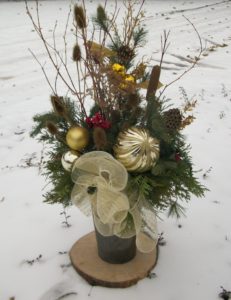It’s Still Just Dirt, The Tillsonburg News – February 2020
by Angela Lassam
Now we have many seed company stands in the stores, it is time to make a list of flowers and vegetables we would like to grow. Some gardeners save seed from the year before but be aware they may not grow true. Most of them have their favourites but it is always good to try something new.
During the wintery days when we browse the seed catalogues there is some good advice and helpful information to guide our choices. Some seeds are best directly sown in the garden and others can benefit from indoor seeding to obtain earlier pleasure.
I thought I would tell you about indoor seeding procedures and some pitfalls. Starting kits are great for first time gardeners and children as they are sterile to start. If you are using old trays you must sterilize them. Wash them in soapy water to remove all dirt then use 1 part bleach to 10 parts water and soak for 10 minutes. Even if they were stored away clean they may have picked up mold and insects especially spiders. Sterilize any tools you may be using too.
Some people use saved seeds or even seeds from the previous year. It is wise to do the ‘baggy method’ to check germination. This is when you take a plate with moist paper towel, sprinkle on a few seeds and seal in a sandwich bag. Wait a few days and check to see how many have sprouted. This will save wasted space and planting materials.
The first seeds to start are usually perennials and other longer germinating seeds. Peppers and tomatoes take longer than flower seeds generally. Marigolds germinate easily but do not cover seeds with soil use just a dusting.
Some seeds do not do well if started indoors. Cosmos, Zinnias, Nasturtium and Morning Glory are some common ones. Squash, pumpkin, rutabaga, carrots, peas, corn and beans are the vegetables generally directly sown.
Collect all the things you may need – labels, tweezers, pencil for small holes, permanent marker for labeling, plastic covers or sheet plastic, scissors, seed trays and small pots. Now you can start with the longest germinating seeds according to the packet instructions.
The soil for the starting should be a soilless mix preferably as seeds do not need fertiliser until after sprouting and it is of a more fluffy, airy texture for easy growth. It is best taken indoors (maybe overnight) to allow it to be moistened to a soft ball feeling and to be warmed to stop the new seeds from being shocked.
Collect the trays you will be using and fill them 2/3 full of soil. Lightly tap the tray to settle the soil for seeding. Seed packet instructions will tell you the depth of placing the seed. Place 2 or 3 seeds per section or at least 2” apart if using a flat tray. Cover the seed as instructions on the packet as this is important for germination. Some seeds need none or a dusting of cover so follow the packet instructions. Lettuce will not germinate covered. Then lightly mist to settle the seed. Now is the time to label what is sown and the date. Cover with plastic sheeting or place in a plastic bag to retain moisture. Place seed containers in a warm place (at least 70 degrees F.) with as much light as possible but away from draughts. As soon as you see the sprouts remove covering and enjoy watching the growth.
At this time the sprouts must be misted with a fertilizer solution at least twice a week. This is when mold quickly forms on the surface so sprinkle with cinnamon. Alternately a weak camomile tea will work as an antifungal agent. When the seedlings are approximately 3” and past the two leaf stage transplant the strongest seedlings using potting soil. To slow the growth and leggy appearance move them to a cooler spot. Keep misting as surface appears dry or sit tray in water to soak from the bottom for a short time. Never waterlog them as roots are subject to rot.
Indoor seeding is a jump start to our gardening for the year and it is always a good feeling when the seeds poke up through the soil and are nurtured through to the time we can put them in their place outdoors when there is no risk of frost.
The next monthly meeting for the Tillsonburg Horticultural Society is on Tuesday March 3rd @ 7:30 p.m. in the Senior Centre Auditorium, Tillsonburg Community Complex (north side of Complex by the Skate Park). The speaker will be Anita Jacobson, Head Gardener at the Stratford Festival, sharing her gardening skills as designer there since 2006. Everyone welcome, join us for a meeting $4 or become a member for only $20 per year for added benefits. For further information look us up on the website www.tillsonburghortictural.ca and check out Facebook – tillsonburghorticultural.
